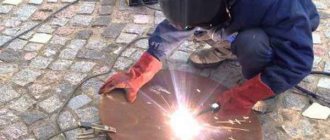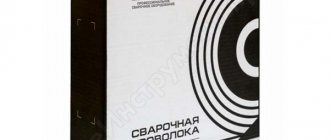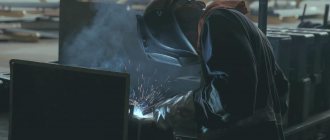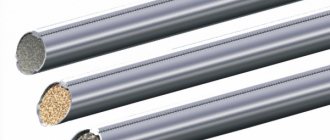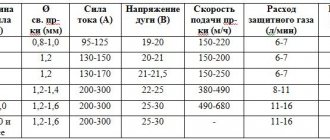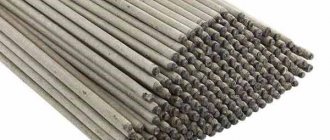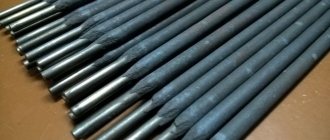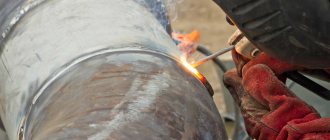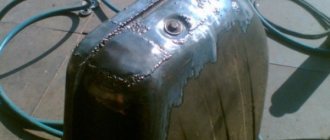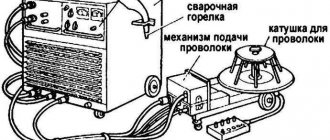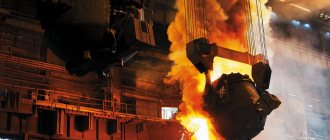Cast iron is used to produce manifolds, pulleys and pipes. The material is characterized by good casting qualities, which helps to produce products of various configurations. However, the alloy has a significant drawback - fragility. When struck, damage occurs, to eliminate which semi-automatic welding of cast iron is used. There are several ways to use such equipment.
Welding work on cast iron is quite complex technologically.
The problem of welding cast iron with a semi-automatic machine
It is difficult to weld cracks in parts made of such an alloy. During the work process, the welder faces the following difficulties:
- The increased fluidity of cast iron prevents the formation of a strong seam. Excessive dilution of the weld pool does not allow a thorough assessment of the quality of the joint. When welding thin plates, burns occur and drops of the melt flow out. The use of fire-resistant substrates helps prevent the development of such a situation. You can learn how to form seams under conditions of increased metal fluidity by regularly practicing on unnecessary workpieces made of a similar alloy.
- Another difficulty is the low melting point. The electric arc heats the welding site to extreme temperatures. Cast iron quickly overheats, which causes gaps to form between the edges and the filler material during the solidification process. If cast iron contains silicon or magnesium additives, hard inclusions appear in the structure of the welded joint, making grinding of the weld more difficult. Slow heating of the workpiece before welding and gradual cooling of the structure after completing the work help to avoid the formation of defects.
- It is also difficult to brew cast iron due to the presence of many pores that arise when carbon is released. Even careful processing of the seam does not improve its aesthetic qualities or increase its resistance to mechanical stress. Copper-plated welding wire is used to protect the connection. The process takes place in a protective gas environment. The filler material used must contain flux.
Cast iron has a low melting point.
How to weld a cast iron engine block
Massive cylinder housings are made from cast iron. This durable material has one significant drawback - it is very fragile.
When struck, cracks form on it or the wall is completely destroyed. Due to small defects, service stations often suggest replacing the engine, although cracks can be effectively eliminated by welding ICE (internal combustion engine) blocks. Is it possible to repair a cast-iron engine block yourself, and how to do it correctly, professionals tell us. They have proven in practice that in a garage, having a welding machine and working skills, it is possible to restore the tightness of the metal and its operating parameters. This engine has been in use for many years.
Types of welding methods available
The method is chosen taking into account the purpose of the parts being connected. The methods differ in the speed of connection formation and the cost of work.
Cold welding method
This is the simplest method of joining workpieces made of an alloy with a high carbon content. The material is not heated before starting work; it must be at room temperature. The cold method is intended for welding structures subject to minimal loads. It can be used to restore worn surfaces of cast iron products.
We recommend reading: How to weld cast iron and steel
Continuous supply of filler material helps to quickly form a seam and carry out large repair work in a short period of time. The connection obtained by the cold method has average performance qualities.
Cold welding is a simple joining method.
Semi-hot method
Before cooking cast iron semi-automatically using this method, the workpieces are heated to +350 °C. To do this, heat from coals is used to create the necessary conditions. Preparatory work prevents changes in the structure of cast iron during welding. In this case, under the influence of an electric arc, fewer cracks appear.
The technology is used in the assembly of structures subject to medium loads.
Hot welding method
This method is used when it is necessary to obtain a strong welded joint. Before starting work, the workpieces are heated to +600 °C. For this purpose, installations that generate inductive currents are used. Cables are connected to the part, and a measuring device monitors the temperature. After reaching the required values, an electric arc is excited, with the help of which a seam is formed.
The hot welding method is used to obtain a strong connection.
Leaving the structure in the ash until completely cooled helps reduce the likelihood of cracks. The duration of the cooling period depends on the thickness of the workpiece.
The hot method helps to obtain a strong, reliable seam, but it is associated with significant time and material costs.
Process description
The optimal technology for hot semi-automatic welding of cast iron involves first heating the metal to 600 degrees, and then immediately starting work. The degree of heating must be carefully monitored. If overheating is allowed, you will have to exclude the slightest ingress of water. Even a single drop can cause cracking and final damage to the product. The welding equipment itself must be carefully configured.
The semiautomatic device is set to a weak direct current and reverse polarity. To accurately weld cast iron using a semi-automatic method, it is necessary to move the holder at an angle of 50 to 60 degrees.
Important: all the time you work, you should visually monitor the tip of the wire and the entire progress of the process. The seams are formed in layers, making 2 or even 3 passes.
Movements in the transverse plane or vibrations during the creation of the first seam are undesirable - this is only acceptable when working with steel.
The second and subsequent passes allow you to relax a little and move the tip of the wire in a transverse plane. When welding is completed, the slag is carefully removed. The metal will cool more evenly if it is covered or sprinkled with non-flammable materials.
Recommendation: it is worth practicing the skill of quickly making a seam and carefully feeding the wire in advance. The supply of inert gases, primarily argon, helps protect the weld pool from the penetration of oxygen.
Basic level semi-automatic machines are distinguished by their single-body design. The general module contains:
- welding current generator;
- wire feeding motor;
- gearbox;
- passive parts of the pushing mechanism;
- gas injection system;
- Control block.
Many people try to brew various cast iron products with carbon dioxide. A common reason for their failures is non-compliance with technology. To partially neutralize carbon monoxide, you need to use wire with a small concentration of manganese. It is recommended to connect the current with reverse polarity, otherwise it is impossible to obtain a truly stable arc. But straight polarity is quite acceptable when metal is being deposited.
In a carbon dioxide environment, oscillators can be used. The wire feed rate is chosen such that the arc remains stable at a specific voltage.
Particular attention should be paid to the size of the working segment of the electrodes. A very large overhang leads to damage to the seam. Very short electrodes make it difficult to monitor the process, and it is often impossible to prevent tip burnout.
Features of semi-automatic welding of cast iron
With the help of such equipment you can restore metal yourself. In this case, any welding mode is selected: MIG welding (using a chemically inactive gas) or MAG welding (surfacing using carbon dioxide).
When using these technologies, the filler material is distributed evenly, and the wire is fed into the weld pool automatically. The use of spot welding on cast iron is not recommended. Due to the limited contact area, thorough heating of the part becomes impossible.
Preparing cast iron for work
The strength of the connection depends on the quality of the edges. Cracks are cut to their full depth before welding. The corners are leveled and polished. The cutting should exceed the width of the defect by 1-2 cm, the depth by 1-2 mm. The locking points are drilled, which increases the reliability of the connection. The cutting is performed at an angle of 45°. Oil stains are removed with a degreasing agent or burned. A graphite stand is placed under thin workpieces. In this case, the metal will not spread. The edges are cleaned of chips and dust, which reduce the strength of the joint.
We recommend reading: How to work with cast iron using cold welding
Before welding, cast iron must be leveled and ground.
Filler wire selection
Consumable electrodes are used for welding in a carbon dioxide environment. You cannot use regular wire on steel. This contributes to the appearance of a large number of cracks during the cooling process. The choice of wire for cast iron is determined by the welding mode:
- when working with the cold method, consumable electrodes PP ANCh-1 are used;
- the semi-hot method involves the use of the additive PP ANCh-2;
- when welding with heating up to +600 °C, use PP ANCH-3.
The “PP” symbols in the marking indicate the presence of a powder-filled core.
The material contains all the filler components necessary for welding (silicon, iron, copper, nickel). They make the seam stable and durable.
Necessary equipment
Semi-automatic welding is carried out using a machine that continuously supplies filler material into the weld pool. The work area must also be protected with gas or flux. Simple semi-automatic machines are represented by a single module that combines a gearbox, an engine, a feed mechanism, and a gas exhaust system. For large volumes of work, composite equipment is used. The gas burner and the wire feeder of such a unit are enclosed in separate housings. Taking into account the design of electrical circuits, devices are divided into:
- Single-phase semiautomatic devices. They are characterized by compact size and ease of connection to the network. The devices operate from household 220 V sockets.
- Three-phase units. Powered by industrial electrical network 380 V.
Welding is carried out using a semi-automatic machine.
When choosing a device, take into account the type of feeding mechanism, which can be:
- Pushing, located within the body. The device delivers the additive into the sleeve. If you use thin wire, the material may get stuck.
- Pull, built into the burner handle. It draws in the additive, feeding it evenly into the weld pool. The disadvantage is the possibility of excessive thinning of the wire.
- Combined, combining 2 types of mechanisms. The nodes work synchronously, ensuring a stable supply of consumables.
Welding process
The connection of cast iron blanks is performed as follows:
- Prepare the edges of the parts and install a backing if necessary.
- When using the semi-hot or hot method, the parts are heated to the desired temperature. When working with the cold method, this step is skipped.
- Fix the workpieces in the correct position. Start the gas supply, after 10 seconds the electric arc is ignited.
- Slowly move the torch along the seam, holding the tool at an angle.
- The seam is welded again (depending on the thickness of the metal, the action is performed 2-5 times). At this stage, transverse guidance of the electrode is allowed.
- They break the arc and turn off the gas after 30 seconds.
- Clean the seams and leave them under an asbestos or coal layer to cool slowly.
- Perform final connection processing.
We recommend reading: How to weld a cast iron vice with your own hands
The parts are heated to the required temperature.
Horizontal seam
Semi-automatic welding makes it possible to produce horizontal seams of the highest quality, regardless of the direction of movement. To obtain a high-quality seam, you need to take into account some features:
- it is necessary to balance the gravity of drops of molten metal and the burning force of the electric arc;
- it is important to choose the optimal speed of moving the electrode along the joint;
- To control the melt, welding work should be carried out continuously.
In some cases, it is not possible to complete the seam in one pass. Then you can resort to a technique that involves periodically extinguishing the arc. Various welding patterns can be used on workpieces with edges up to 4 mm. In all other respects, the quality of the seam will depend on the experience and skill of the welder.
A horizontal weld is created in four stages:
- Formation of the root roll. It is performed with a short electric arc. The electrode is held at an angle of 80 degrees in relation to the working surface. The primary roller is formed, as a rule, at maximum current.
- Secondary roller application. Before starting the process, the average current strength is set. The roller is performed in one pass using an electrode of the largest possible diameter. When forming a roller, the forward angle technology is used.
- Creating the third roller. Depending on the previously obtained results, one of two methods is used to form the third roller. The area of the secondary roller is large - the third one lies in the center. When the dimensions of the secondary correspond to the norm, then the third stage is performed in two approaches.
- Checking the quality of work.
Welding defects most often form in the upper part of the seam. Therefore, you should carefully monitor the quality of work at this stage.
How to cook malleable and high-strength cast iron
Work with these types of alloy is carried out in a carbon dioxide environment using Np-30GHSA, Sv-08G2S or Sv-08GS wire. Preheating of the workpieces is not required. During the welding process, the following rules are observed:
- To reduce the volume of additive in the weld, welding is carried out by covering 1/3 of the width of the bead. The arc should be directed towards the melt. To preserve the structure of cast iron, a method of cascade formation of a joint using annealing rollers is used.
- The use of Np-30GHSA wire promotes the appearance of inclusions in the joint, increasing the strength of the deposited layers.
- Primary welding of especially strong cast iron with steel is performed using consumable material grade Sv-08G2S. The last layer is fused using Np-30GHSA wire.
When does it not make sense to weld with argon?
Often during the operation of a car, it becomes necessary to change the sensor in the engine housing or spark plugs. It may well turn out that these elements are too tight. In this case, the master or owner may apply excessive force and simply break off a piece of the unit. If this was done at the place where the spark plug was installed, you will have to buy a new block. When attempting to weld, the following processes will occur:
- the technician will restore the damaged area as carefully as possible, but the seat diameter can no longer be made ideal for the candle;
- you can use the option of melting, and then drilling and cutting the required thread, but it is also impossible to maintain the required installation height of the candle;
- if we are talking about a sensor, it is also simply melted and not used in the future, because otherwise you will have to perform incredibly difficult work to restore the installation site;
- if there is a crack in the body itself from the outside, you can be sure that there is a crack on the inside, so it can only be welded in certain situations that a specialist knows about;
- unprofessional argon welding will bring big problems, in this case it is better not to do any work with a broken cylinder block, but simply buy a new one.
Welding with an argon mixture occurs using a tungsten electrode, which heats up to a temperature of about 4000 degrees at maximum mode. This requires not only increased caution, but also fairly high professionalism. Simply place the electrode in the wrong spot, and it will simply make another hole instead of welding the necessary elements of your engine.
Correction of welding defects
The method of elimination depends on the type of deficiency:
- A crater, which is a depression at the end point, reduces the strength of the joint. It is welded again, breaking the arc at the finished section of the seam.
- Undercut - local thinning of the metal is eliminated by fusing a new layer. If the depth of the defect is small, mechanical cleaning is used.
- Lack of penetration occurs when the welding process is interrupted and resumed incorrectly. Such defects negatively affect the resistance of the connection to impacts. To eliminate lack of penetration, increase the current strength.
- Sagging is formed when the melt hits the surface of the part. To prevent its occurrence, increase the arc voltage and reduce additive consumption. Eliminate the defect mechanically.
- A burn-through is a through hole formed when the melt flows out. To eliminate the defect, the damaged areas are re-cleaned and boiled.
The strength of the finished structure depends on the quality of welding. Therefore, after completing the work, carefully inspect the seam.
Preparation for work operations
Regardless of the welding method and equipment used, cast iron workpieces require special preparation. Its surfaces must be cleaned of dirt, oil stains and, if possible, scale with traces of corrosion must be removed. Next, use a chisel or angle grinder to expand the edges along the entire length. If you plan to repair cracks by welding, then initially drill holes in the places where defects form. Using the created recesses, it will be easier to perform high-quality semiautomatic welding of cast iron with optimal penetration into the crack formation zone. Workpieces with a thickness of more than 5 mm are subjected to turning to obtain 50-60 degree angular chamfers along the edges. Thin parts, as noted above, are welded using graphite pads, eliminating the risk of through burning.
What to consider when organizing a protective environment?
Two aspects need to be considered. Firstly, this is equipment that will provide gas supply to the burner. Secondly, the type and properties of the gas itself. For technical organization, you will need a cylinder with the appropriate filling and mounting and connecting fittings with a nozzle, gearbox and other necessary equipment. As for the second aspect, balanced semi-automatic welding of cast iron in a carbon dioxide environment is the most common method. Carbon dioxide as such is self-sufficient and provides the necessary protection for welding. Another thing is that it does not always guarantee arc stability and does not perform well during high-precision work. An alternative option would be an argon or carbon dioxide-argon mixture, which opens up more opportunities for producing modified alloyed alloys.
Read also: Circular saw for wood
Advantages
- There is virtually no lengthy prep work, as happens with other problematic metals;
- The welding productivity process becomes more efficient when the correct consumables are used;
- After restoration, the load-bearing capacity of the welded parts becomes higher if the welding process was carried out with sufficient quality;
- Suitable for both manual gas welding and semi-automatic argon arc welding;
- The wire expands the possibilities for repairing cast iron products;
- The composition is balanced for heat treatment of cast iron;
- Compared to welding with electrodes, the material consumed here is a quarter less.
( 2 ratings, average 4 out of 5 )
Safety precautions
Performing welding in a production environment requires that the performer be certified to carry out the relevant type of work.
The hot welding area must be equipped with special equipment that performs the function of removing dust generated during welding.
There are also general rules that must be followed by both professional welders and home craftsmen:
- The welding machine must be grounded , which guarantees the safety of the performer.
- of personal protective equipment is mandatory .
- Electric welding at home should be carried out in a well-ventilated and lit area .
